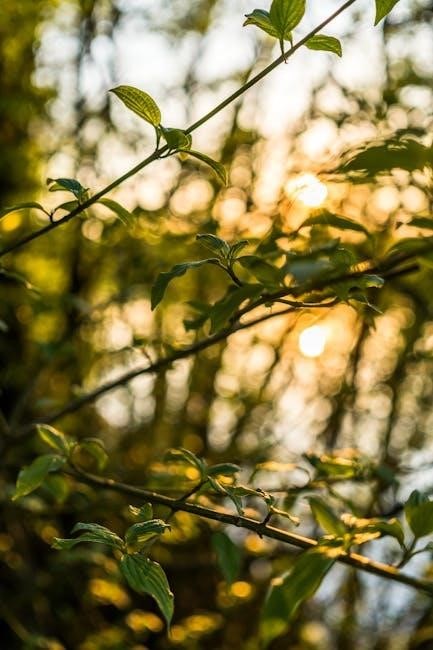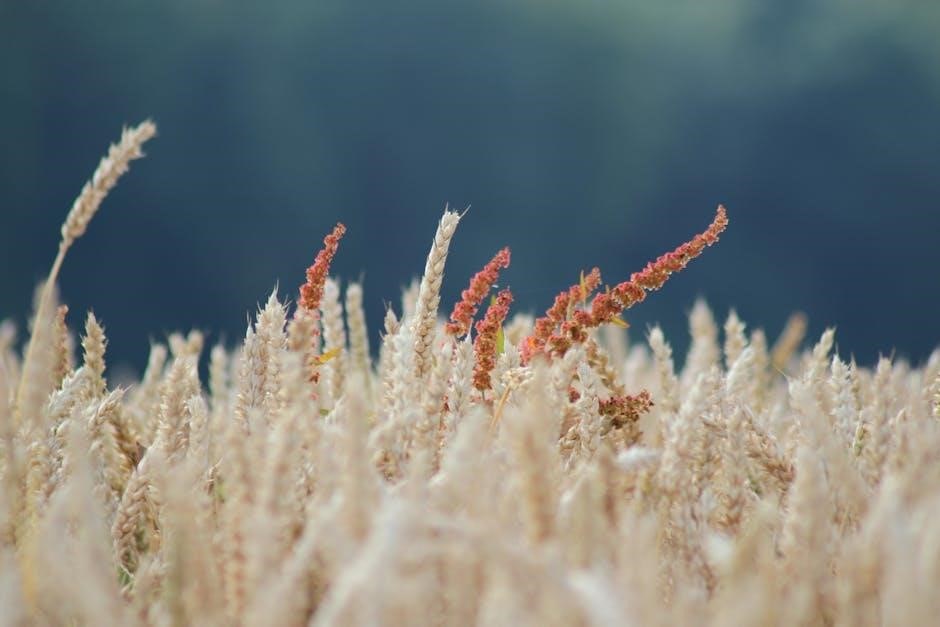Hallucinogenic plants have long fascinated humanity, offering insights into altered consciousness and spiritual exploration. A golden guide to these plants provides a comprehensive overview of their cultural significance, physiological effects, and practical cultivation methods. These plants hold a unique role in human history, blending tradition with modern interest in psychoactive experiences.
Overview of Hallucinogenic Plants
Hallucinogenic plants are species containing psychoactive compounds that alter perception, thought, and mood. These plants, such as peyote, ayahuasca, and psychoactive mushrooms, have been used for centuries in rituals and ceremonies. They produce profound sensory and psychological effects, often described as transformative. A golden guide to hallucinogenic plants explores their diversity, from tropical rainforest species to desert cacti. These plants are rich in alkaloids like DMT, mescaline, and psilocybin, which interact with the human brain to create vivid hallucinations. Understanding their chemistry, history, and cultural significance provides insight into their role in human spirituality and modern psychoactive exploration.
Importance of Understanding Hallucinogenic Plants
Understanding hallucinogenic plants is crucial for appreciating their historical, cultural, and scientific significance. These plants have shaped spiritual practices, rituals, and traditions across ancient civilizations. By studying them, we gain insights into human consciousness, cultural evolution, and the potential therapeutic benefits of psychoactive compounds. A Golden Guide to hallucinogenic plants offers a detailed exploration of their roles in primitive and modern societies, highlighting their impact on personal development and spiritual growth. This knowledge fosters respect for their power and encourages responsible use, bridging the gap between tradition and modern scientific inquiry into their effects and ethical implications.

History of Hallucinogenic Plants
The use of hallucinogenic plants dates back to ancient civilizations, with evidence of their role in rituals and spiritual practices. This guide explores their historical significance and traditional applications in fostering enlightenment and cultural evolution.
Ancient Civilizations and Hallucinogenic Plants
Ancient civilizations deeply valued hallucinogenic plants for their spiritual and ritualistic significance. Evidence from Chavín de Huántar reveals the use of DMT-related plants in secretive ceremonies, potentially to elevate social status among leaders. These plants were integral to shamanic practices, enabling communication with the divine and guiding communal decisions. Ritual artifacts and residues confirm their ceremonial role, showcasing how ancient cultures harnessed their psychoactive properties for transcendental experiences. Such practices underscore the enduring connection between hallucinogenic plants and human spirituality, bridging the gap between the physical and mystical worlds. Their legacy continues to inspire modern explorations of consciousness and cultural heritage.
Historical Use in Rituals and Ceremonies
Hallucinogenic plants have been integral to ancient rituals and ceremonies, serving as gateways to spiritual realms and divine communication. In Chavín de Huántar, residue of DMT-related plants on artifacts suggests their use in sacred rites. Leaders likely controlled access to these substances to enhance their status and influence. Rituals often involved hallucinogenic plants to induce trance-like states, fostering spiritual growth and communal bonding. These practices highlight the deep cultural and religious significance of psychoactive plants in early societies, emphasizing their role in bridging the human and divine worlds.
Cultural and Spiritual Significance
Hallucinogenic plants have deep cultural and spiritual meaning, often used in ancient rituals for spiritual growth and heightened perception. A golden guide highlights their role in ceremonial practices.
Role in Indigenous Cultures
Hallucinogenic plants have played a profound role in indigenous cultures, serving as sacred tools for spiritual, medicinal, and communal rituals. In ancient civilizations like Chavín de Huántar, these plants were integral to religious ceremonies, often used to connect with the divine or ancestors. Leaders utilized hallucinogens to assert authority and prestige, as evidenced by the discovery of DMT-related residues on ritual artifacts. Indigenous communities have traditionally revered these plants, employing them in shamanic practices to heal, inspire wisdom, and foster collective harmony. Their cultural significance is deeply intertwined with spiritual identity and the preservation of ancestral traditions, as highlighted in A Golden Guide to Hallucinogenic Plants.
Modern Spiritual and Recreational Use
The modern use of hallucinogenic plants spans spiritual practices, personal growth, and recreational exploration. Many individuals seek these plants for introspection and profound psychological experiences. Retreats offering ayahuasca ceremonies have gained popularity worldwide, blending traditional rituals with contemporary wellness practices. Similarly, peyote is used in modern spiritual circles to foster connection and self-discovery. Recreationally, these plants are often used in controlled settings, such as music festivals, to enhance creativity and social bonding. A golden guide to hallucinogenic plants provides insights into safe practices, emphasizing responsible use and awareness of legal and ethical considerations. This modern resurgence highlights their enduring appeal and versatility.
Botanical Overview
Hallucinogenic plants encompass a diverse range of species, including peyote, ayahuasca, and psychoactive mushrooms. These plants are known for their unique alkaloids and psychedelic properties, as highlighted in guides.
Common Species of Hallucinogenic Plants
Some of the most well-known hallucinogenic plants include peyote (Lophophora williamsii), ayahuasca (Banisteriopsis caapi), and psilocybin mushrooms. Peyote contains mescaline, inducing vivid visions, while ayahuasca combines DMT with MAO inhibitors for profound psychoactive effects. Psilocybin mushrooms, such as Psilocybe cubensis, produce intense sensory alterations. Other notable species include DMT-containing plants like Psychotria viridis and Diplopterys cabrerana, commonly used in shamanic rituals. Morning glory (Ipomoea violacea) and Hawaiian baby woodrose (Arundo donax) are also recognized for their psychoactive properties. These plants have been central to both traditional and modern explorations of consciousness.
Growth and Habitat of Hallucinogenic Plants
Hallucinogenic plants thrive in diverse environments, from tropical rainforests to arid deserts. Species like peyote prefer well-drained soil in dry climates, while ayahuasca flourishes in the humid Amazon basin. Many psychoactive plants require specific conditions, such as high humidity or full sunlight, to grow effectively. Understanding their natural habitats is crucial for successful cultivation. For example, plants like peyote and ayahuasca are adapted to regions with distinct soil and climatic profiles. This knowledge helps enthusiasts and researchers replicate ideal environments, ensuring healthy growth and potency. Such insights are often detailed in guides, offering practical advice for cultivating these unique species responsibly.

Chemical Composition and Effects
Hallucinogenic plants contain alkaloids and psychedelic compounds like DMT, altering perception and consciousness. These chemicals interact with the brain, inducing profound sensory and cognitive transformations in users.
Alkaloids and Psychedelic Compounds
Hallucinogenic plants contain powerful alkaloids and psychedelic compounds that alter perception and consciousness. Alkaloids like DMT, psilocybin, and mescaline are key psychoactive substances, interacting with the brain’s serotonin receptors to produce vivid visuals and altered states. These compounds are naturally occurring, often concentrated in specific parts of the plant, such as leaves or seeds. Understanding their chemical structure is essential for grasping their effects, as they mimic neurotransmitters, influencing mood, cognition, and sensory experiences. The unique chemistry of these plants has fascinated scientists and users alike, offering insights into both therapeutic potential and recreational use.
Physiological and Psychological Effects
Hallucinogenic plants alter perception, thought, and mood through psychoactive compounds like DMT, psilocybin, and mescaline. These substances interact with serotonin receptors in the brain, causing vivid visuals, sensory distortions, and altered time perception. Physiological effects include dilated pupils, increased heart rate, and nausea. Psychologically, users may experience euphoria, introspective insights, or overwhelming emotional shifts. The effects vary depending on the plant, dosage, and individual tolerance. While some report profound spiritual experiences, others may face anxiety or disorientation. Understanding these effects is crucial for safe and mindful use, as documented in guides like A Golden Guide to Hallucinogenic Plants.

Risks and Safety Considerations
Using hallucinogenic plants poses potential health risks, including psychological instability and legal consequences. A golden guide emphasizes responsible use and adherence to legal regulations to ensure safety.
Potential Health Risks
The use of hallucinogenic plants carries significant mental and physical health risks. These substances can alter perception, leading to unpredictable reactions, including anxiety, paranoia, or psychosis in susceptible individuals. Prolonged use may result in dependency or long-term psychological instability. Certain plants contain toxic compounds that can harm the body, affecting the cardiovascular and nervous systems. Additionally, improper dosing or mixing with other substances can exacerbate adverse effects. While some plants have therapeutic potential, misuse without medical supervision can be dangerous. It is crucial to approach these substances with caution and consult healthcare professionals to mitigate risks and ensure safe use.
Legal Status and Regulations
The legal status of hallucinogenic plants varies widely across the globe. Many species, such as peyote and ayahuasca, are classified as controlled substances in several countries due to their psychoactive properties. However, some regions allow their use in religious or traditional ceremonies under specific regulations. For instance, peyote is legal for religious use by Native American tribes in the United States. International laws often restrict the cultivation and distribution of these plants, but enforcement can be inconsistent. Legal frameworks are continually evolving, reflecting changing attitudes toward psychoactive substances and their potential therapeutic benefits. Responsible use and adherence to local laws are essential.
Cultivation and Harvesting
Cultivating hallucinogenic plants requires precise methods and care, ensuring optimal growth and potency. A golden guide provides detailed instructions for propagation, soil conditions, and harvesting techniques.
Methods and Best Practices
Growing hallucinogenic plants requires precise methods and adherence to best practices to ensure healthy growth and potency. Soil quality, watering schedules, and light exposure are critical factors. Ethical practices, such as sustainable harvesting, are essential to prevent over-exploitation; Legal compliance is also crucial to avoid legal repercussions. By following these guidelines, cultivators can successfully grow hallucinogenic plants while maintaining environmental balance and respecting their cultural significance.

Ethical and Environmental Concerns
The cultivation and use of hallucinogenic plants raise significant ethical and environmental concerns. Over-harvesting wild species, such as peyote, has led to their endangerment, highlighting the need for sustainable practices. Deforestation and habitat destruction are additional risks when plants are cultivated on a large scale. Ethically, there are questions about cultural appropriation, as many hallucinogenic plants are central to indigenous traditions. Ensuring fair trade and respecting cultural heritage are crucial. Additionally, the legal and ethical implications of psychoactive plant use must be balanced with environmental preservation to avoid ecological harm and promote responsible practices.
